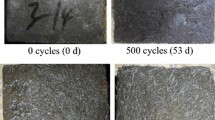Abstract
The effect of electrochemical chloride extraction (ECE) on bond strength between steel bar and freeze-thaw concrete contaminated by chloride was experimentally investigated for beam specimens with dimensions of 100 mm×100 mm×400 mm. During the experiment, 3% NaCl (vs mass of cement, mass fraction) was mixed into concrete to simulate chloride contamination, and the specimens experienced 0, 25, 50, 75 freeze-thaw cycles before ECE. In the process of ECE, different current densities and durations were adopted. It is indicated that the bond strength between reinforcement and concrete decreases with the increase of freeze-thaw cycles; the more the current and the electric quantity of ECE are, the more the loss of bond strength is; and the largest loss is up to 58.7%. So, it is important to choose proper parameters of ECE for the reinforced concrete structures contaminated by chloride and subjected to freeze-thaw cycles.
Similar content being viewed by others
References
SWAMY R N, STEPHEN M. Effectiveness and structural implications of electrochemical chloride extraction from reinforced concrete beams [J]. Cement and Concrete Composites, 2006, 28(8): 722–733.
BUENFELD N R, BROOMFIELD J P. Influence of electrochemical chloride extraction on the bond between steel and concrete [J]. Magazine of Concrete Research, 2000, 52(2): 79–91.
TOUMI A, FRANCOIS R, ALVARADO O. Experimental and numerical study of electrochemical chloride removal from brick and concrete specimens [J]. Cement and Concrete Research, 2007, 37(1): 54–62.
ORELLAN J C, ESCADEILLAS G. Electrochemical chloride extraction: Efficiency and side effects [J]. Cement and Concrete Research, 2004, 34(2): 227–234.
RASHEEDUZZAFAR M G. Degradation of bond between reinforcing steel and concrete due to cathodic protection current [J]. ACI Materials Journal, 1993, 90(1): 17–25.
IHEKWABA N M, HOPE B B, HANSSON C M. Pull-out and bond degradation of steel rebars in ECE concrete [J]. Cement and Concrete Research, 1996, 26(2): 267–282.
HOSSEINI A, KHALOO A R. Study of electrochemical chloride extraction as a non-destructive repair method: Part I. Discrete test samples [J]. Asian Journal of Civil Engineering: Building and Housing, 2005, 6(3): 167–182.
HOSSEINI A, KHALOO A R. Study of electrochemical chloride extraction as a non-destructive repair method: Part II. Structural element test sample [J]. Asian Journal of Civil Engineering: Building and Housing, 2005, 6(4): 247–255.
WANG Chuan-zhi, TENG Zhi-ming. Theory of reinforced concrete structure [M]. Beijing: Architecture Industry Press, 1985. (in Chinese)
GONG Jin-xing, HE Shi-qin, GUO Yu-xia. Influence of freezing and thawing cycles on bond characteristics of steel bar and concrete in salt environment [J]. Journal of Dalian University of Technology, 2005, 45(3): 405–409. (in Chinese)
CHANG J J. Bond degradation due to the desalination process [J]. Construction and Building Materials, 2003, 17(4): 281–287.
JI Xiao-dong, SONG Yu-pu, LIU Yuan. Effect of freeze-thaw cycle on bond strength between steel bars and concrete [J]. Journal of Wuhan University of Technology: Materials Science Edition, 2008, 23(4): 584–588.
RACGEK H D, BRIAN J D. Assessing the durability of concrete in freezing and thawing [J]. ACI Materials Journal, 1989, 86(1): 29–35.
NZERIBE M I, BRIAN B H. Mechanical properties of anodic and cathodic regions of ECE treated concrete [J]. Cement and Concrete Research, 1996, 26(5): 771–780.
BIKULCHUS G. Chloride removal from reinforced concrete and relevant loss of strength [J]. Protection of Metals, 2005, 41(5): 484–486.
MIRANDA J M, COBO A, OTERO E, GONAÁLEZ, Limitations and advantages of electrochemical chloride removal in corroded reinforced concrete structures [J]. Cement and Concrete Research, 2007, 37(4): 596–603.
KOLEVA D A, BREUGEL K, WIT J H W. Correlation of microstructure, electrical properties and electrochemical phenomena in reinforced nortar. Part I: Microstructural observations and electrical properties [J]. Materials Characterization, 2008, 59(3): 290–300.
Author information
Authors and Affiliations
Corresponding author
Additional information
Foundation item: Project(IRT0518) supported by the Program of Innovative Team of the Ministry of Education of China
Rights and permissions
About this article
Cite this article
Guo, Yx., Gong, Jx. Degradation of bond between steel bar and freeze-thaw concrete after electrochemical chloride extraction. J. Cent. South Univ. Technol. 17, 388–393 (2010). https://doi.org/10.1007/s11771-010-0057-8
Received:
Accepted:
Published:
Issue Date:
DOI: https://doi.org/10.1007/s11771-010-0057-8




